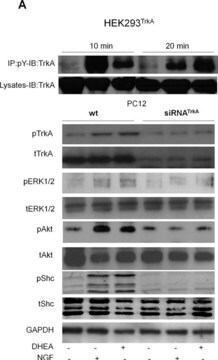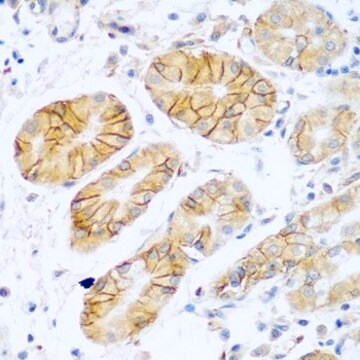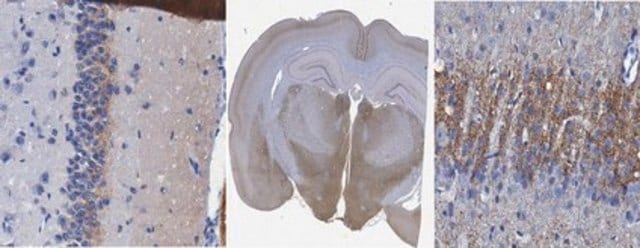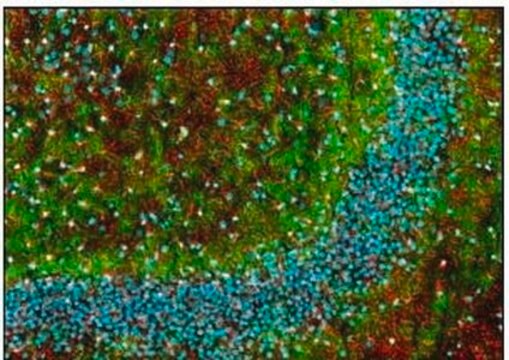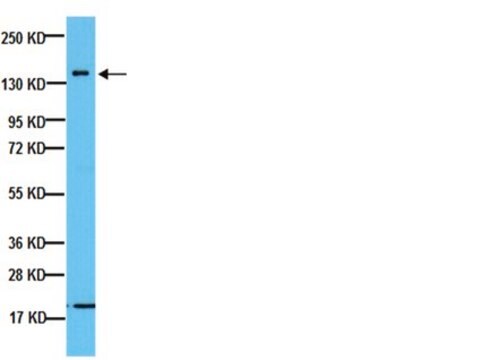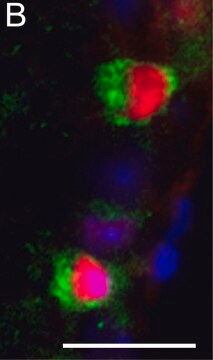MABF959
Anti-CD47 Antibody, clone C5/D5
clone C5/D5, from mouse
Synonym(e):
Leukocyte surface antigen CD47, Antigenic surface determinant protein OA3, CD47, IAP, Integrin-associated protein, Protein MER6
About This Item
Empfohlene Produkte
Biologische Quelle
mouse
Qualitätsniveau
Antikörperform
purified immunoglobulin
Antikörper-Produkttyp
primary antibodies
Klon
C5/D5, monoclonal
Speziesreaktivität
human
Methode(n)
flow cytometry: suitable
Isotyp
IgG1κ
NCBI-Hinterlegungsnummer
UniProt-Hinterlegungsnummer
Versandbedingung
ambient
Posttranslationale Modifikation Target
unmodified
Angaben zum Gen
human ... CD47(961)
Verwandte Kategorien
Allgemeine Beschreibung
Spezifität
Immunogen
Anwendung
Entzündung & Immunologie
Flow Cytometry Analysis: A representative lot detected the expression of exogenously transfected human CD47 on the surface of CaCO2 cells (Liu, Y., et al. (2001). J. Biol. Chem. 276(43):40156-40166).
Flow Cytometry Analysis: Representative lots detected human polymorphonuclear (PMN) neutrophils surface CD47 immunoreactivity, which was upregulated after fMLP stimulation (Liu, Y., et al. (2001). J. Biol. Chem. 276(43):40156-40166; Parkos, C.A., et al. (1996). J. Cell Biol. 132(3):437-450).
Immunoaffinity Purification: A representative lot was immobilized on resins and employed for affinity purification of CD47 from HT29 (subclone Cl 19.A) lysate (Parkos, C.A., et al. (1996). J. Cell Biol. 132(3):437-450).
Immunocytochemistry Analysis: A representative lot immunostained the basolateral surfaces of methanol-fixed CaCO2 monolayers expressing exogenously transfected human CD47 by fluorescent immunocytochemistry (Liu, Y., et al. (2001). J. Biol. Chem. 276(43):40156-40166).
Immunocytochemistry Analysis: A representative lot immunostained the basolateral membrane of paraformaldehyde-fixed T84 human intestinal epithelial cell monolayer by fluorescent immunocytochemistry (Parkos, C.A., et al. (1996). J. Cell Biol. 132(3):437-450).
Immunofluorescence Analysis: A representative lot immunostained the colonic crypts and lamina propria leukocytes at the basal and lateral, but not apical, aspects of the epithelium in paraformaldehyde-fixed frozen human colon tissue sections by fluorescent immunohistochemistry (Parkos, C.A., et al. (1996). J. Cell Biol. 132(3):437-450).
Immunoprecipitation Analysis: A representative lot immunoprecipitated ~60-65 kDa glycosylated CD47 from T84 human intestinal epithelial cell lysate. Target band size reduced to ~35 kDa following deglycosylation by N glycosidase F treatment (Parkos, C.A., et al. (1996). J. Cell Biol. 132(3):437-450).
Neutralizing Analysis: Representative lots caused a delay of human polymorphonuclear (PMN) neutrophils migration across polarized monolayers of T84 human intestinal epithelial cells in a bidirectional fashion without affecting PMN neutrophils or T84 adhesion. Tyrosine phosphorylation inhibitor genistein prevented delay by clone C5/D5 (Liu, Y., et al. (2001). J. Biol. Chem. 276(43):40156-40166; Parkos, C.A., et al. (1996). J. Cell Biol. 132(3):437-450).
Qualität
Flow Cytometry Analysis: 0.4 µL of this antibody detected CD47 surface expression on the gated lymphocytes population among one million human PBMCs.
Zielbeschreibung
Physikalische Form
Lagerung und Haltbarkeit
Handling Recommendations: Upon receipt and prior to removing the cap, centrifuge the vial and gently mix the solution. Aliquot into microcentrifuge tubes and store at -20°C. Avoid repeated freeze/thaw cycles, which may damage IgG and affect product performance.
Sonstige Hinweise
Haftungsausschluss
Sie haben nicht das passende Produkt gefunden?
Probieren Sie unser Produkt-Auswahlhilfe. aus.
Lagerklassenschlüssel
12 - Non Combustible Liquids
WGK
WGK 2
Flammpunkt (°F)
Not applicable
Flammpunkt (°C)
Not applicable
Analysenzertifikate (COA)
Suchen Sie nach Analysenzertifikate (COA), indem Sie die Lot-/Chargennummer des Produkts eingeben. Lot- und Chargennummern sind auf dem Produktetikett hinter den Wörtern ‘Lot’ oder ‘Batch’ (Lot oder Charge) zu finden.
Besitzen Sie dieses Produkt bereits?
In der Dokumentenbibliothek finden Sie die Dokumentation zu den Produkten, die Sie kürzlich erworben haben.
Unser Team von Wissenschaftlern verfügt über Erfahrung in allen Forschungsbereichen einschließlich Life Science, Materialwissenschaften, chemischer Synthese, Chromatographie, Analytik und vielen mehr..
Setzen Sie sich mit dem technischen Dienst in Verbindung.